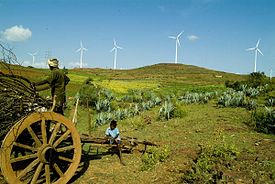Navjot Singh / Operations Manager / Tawanai EnergyTech Pvt. Ltd. / India
Over the last decade or so, wind energy has emerged as one of the mainstream options for grid quality electricity generation. Since 2000 till end 2017, global wind power capacity has grown at a Compound Annual Growth Rate (CAGR) of 22%. From 18 GW in 2000, the capacity has grown to 540 GW.
While the wind energy industry definitely seems to have a promising future, yet like most other industries, this industry too suffers from asymmetric information. Variability of wind and its dependence on site conditions and climatic factors makes the task of appropriate turbine selection and site selection a highly technical and tedious process.

Variability of wind and its dependence on site conditions and climatic factors makes the task of appropriate turbine selection and site selection a highly technical and tedious process.
The performance of wind turbines depends on various factors like wind speed, the variation of wind speed with height, turbulence, air density, elevation of the site, terrain conditions, and surface conditions such as presence of trees, deserts, oceanic surface, etc. In addition to factors external to the wind turbine such as those mentioned above, there are certain aspects internal to machine design such as the rotor diameter, hub height (height of the tower), pitching mechanism, aerofoil design, coefficient of performance, and thrust coefficient that also impact wind turbine output. Many of these internal factors are inherently contained in the power curve (a curve that marks power output at different wind speeds) of the wind turbine.
Thus, in totality, the output of a wind turbine is subject to many parameters that vary from site to site and wind turbine to wind turbine, sometimes even within a few meters.
Given that today a large number of wind turbine models are available, for anyone planning to invest in a wind farm a sensitivity analysis for so many factors for each wind turbine performance is a long and tedious process. To arrive at the most optimal solution given the various types of wind turbine models and differing site conditions, the investor must examine the performance of each wind turbine model under different conditions. In evaluating different models, one may not only lose precious time but also end up making calculation errors (and in some cases, theoretical errors), thereby leading to investment decisions that may not be optimal given the available resources.
Windzberg Wind Turbine & Resources Data Yearbook being brought out by Tawanai EnergyTech fills this gap on the analytical aspects of wind resource and wind farm planning in the form of a ready reckoner for independent power producers (IPPs), investors, banks, financial institutions, consultancies, wind turbine manufacturers, educational institutions, research institutions, government organizations, and wind energy experts. It provides a technical analysis with all parameters that would change from project to project between different technology types, thus speeding up selection of the right technology for maximum energy generation at any given site.
Currently, in order to ascertain how much electricity will be generated by the wind turbine in a given wind regime, complex and cumbersome calculations have to be performed. Before zeroing in on a site, a wind farm developer needs to screen many options to select the most suited or economically the best option. For this, usually, a wind-farm developer depends on specialist consultants, who run various models such as WaSP, Windfarmer, and WindPro or the CFD models to assess annual energy generation or annual energy production (AEP) from a wind farm. Depending on the size of the wind farm, number of data points, number of wind turbines, the data itself and site complexity, the simulation process for any one model of a wind turbine can take from a few hours to a week. However, these consultants are also working for a number of clients and it is only seldom that they can take up the exercise on demand. The waiting period for a single simulation or energy assessment report can be a month or more. Thus developers often end up spending months in screening sites and shortlisting wind turbines.
Though it is recommended to carry out thorough detailed analysis once before the final investment decision, it is not a requirement for selecting alternate sites or screening different types of wind turbines. Windzberg DY – 2018 has made screening and sensitivity analysis so easy that the entire task of screening alternate sites and different wind turbines can be easily carried out by a non-specialist graduate engineer in about a day. The task of complex simulations can be done away with entirely.
The saving in terms of time and money can be quite significant. It is not only about the time and cost of the various simulation packages, professionals, and consulting organizations but also the cost of delay in investment. The investment in a wind farm project is typically on the order of a million dollars per MW. For a 100-MW wind farm, this would be $100 million. Even a delay of two months in the project coming online implies a loss in generation of nearly $2 million.
Windzberg DY – 2018 is an enormous task achieved in one-time analysis and compilation for the industry. It is a game changer in how one goes about selecting sites.
It is aimed at bringing about greater technical transparency in the wind energy industry and we are hopeful that Windzberg Data Yearbook 2018 will enable key stakeholders to make decisions for efficient and optimum generation on their wind farms.
Could this be an end of cumbersome complex computing and tab files? Well, maybe. You could discover for yourself.
Those interested may contact: nayyara@tawanai.in
Filed Under: Uncategorized




